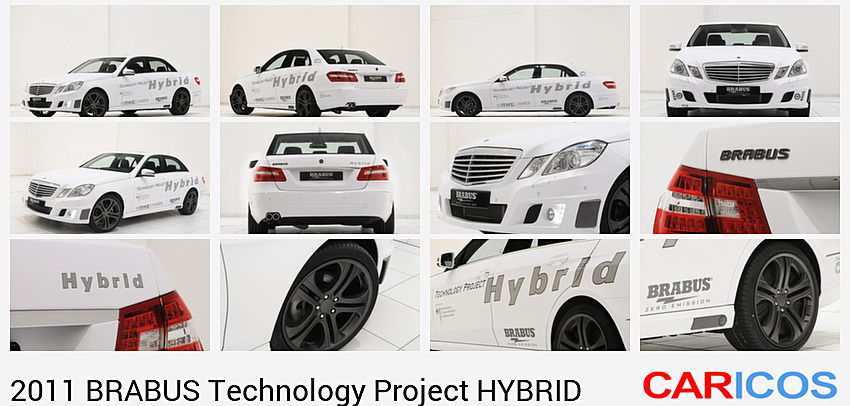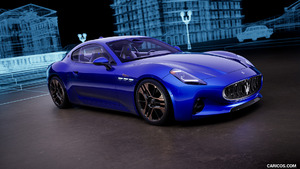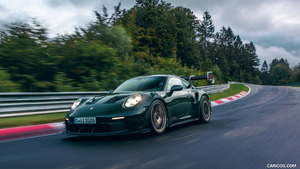BRABUS Technology Project HYBRID
Based on the Mercedes-Benz E 220 CDI BlueEFFICIENCY
Based on the Mercedes-Benz E 220 CDI BlueEFFICIENCY
BRABUS combines the best of two worlds, an efficient direct-injection diesel with BRABUS ECO tuning and two electric wheel hub motors, in a world debut at the 2011 Frankfurt Motor Show IAA. The project vehicle HYBRID was developed by the BRABUS ZERO EMISSION business division, which works on alternative drive technologies, in cooperation with the German Federal Ministry for the Environment, Nature Conservation and Nuclear Safety. This car is an innovative hybrid version of the Mercedes E 220 CDI BlueEFFICIENCY known for its outstanding fuel economy ex-factory. The project vehicle has been developed to small-series-production maturity.
The BRABUS development engineers have adapted two supplemental wheel hub motors from English manufacturer Protean ELECTRIC to the rear axle of the E-Class sedan.
These alternative drives, which in Eco mode each produce 50 kW of continuous power and 80 kW in Sport mode, are designed to fit in the BRABUS Monoblock Q 19-inch wheels.
With a combined peak power output of 160 kW and a total peak torque of 1,600 Nm (1,180 lb-ft) the two electric motors supplement the existing 2.2-liter common-rail turbodiesel engine, which was equipped with a BRABUS ECO PowerXtra D3 (V) performance kit. This tuning kit consists of an auxiliary control unit that features engine mapping developed on state-of-the-art engine test benches for optimizing fuel economy and CO2 emissions.
The objective of this measure was less the power increase by 30 hp (29 bhp / 22 kW) to 200 hp (197 bhp / 147 kW) produced by the plug-and-play module. Much more important is the increase in peak torque from standard 400 to 450 Nm (295 to 332 lb-ft). It gives the vehicle even more pulling power, regardless of whether the vehicle is in hybrid or conventional operating mode, and results in better fuel economy and reduced CO2 emissions.
The two wheel hub motors turn the four-door car into the even more fuel efficient and ecofriendly BRABUS HYBRID. The various operating modes can be preselected from the cockpit.
During all-electric operation the car is powered by an 18.6-kWh lithium-ion battery pack housed in a custom-made well in the underbody. It gives the BRABUS HYBRID in all-electric Eco mode a maximum operating range of 120 kilometers (75 miles) without any CO2 emissions. Even in Sport mode the car has an all-electric range of 80 kilometers (50 miles), which easily meets the requirements of the majority of motorists who on average drive less than 60 kilometers (37 miles) a day.
During all-electric operation the batteries are charged by energy recuperation. While coasting or braking the system reaches a maximum recuperation power of 140 kW. For charging at home with ecofriendly eco electricity the use of the car charger from German energy provider RWE is recommended. It can recharge the battery pack with a current of 380 volts and a charging capacity of 50 kW in 30 minutes. On the road the batteries can be recharged with the on-board charger on any standard 220 V AC outlet or on a 380 V three-phase power supply.
In hybrid mode, the 200 hp (197 bhp) / 147 kW of the diesel engine and the maximum 160 kW of the electric drive in Sport mode work together in highly efficient fashion. Acceleration time for 0 - 100 km/h (62 mph) improves from standard 8.7 to 7.4 seconds.
Despite of the added weight of 255 kilograms (562 lbs.) compared to a stock E 220 CDI, the BRABUS HYBRID also shines in the area of pulling power thanks to its supplemental electric drive: the intermediate sprint from 60 to 120 km/h (37 to 74 mph) now only takes 5.6 seconds.
At the same time the combination with the electric motors eases the load on the combustion engine, significantly reducing fuel consumption and CO2 emissions further. Naturally drivers have the option to operate solely in diesel mode. In this case the batteries can also be recharged by the wheel hub motors which also function as alternators.
The work of the BRABUS development team was not limited to the integration of the two electric motors for all-electric or hybrid operation alone.
The higher vehicle weight and the altered weight distribution resulting from the installation of the wheel hub motors and the batteries in the rear necessitated the development of a new suspension. A height-adjustable comfortable sports suspension with variable damper rates was developed in cooperation with technology partner BILSTEIN.
The tires are supplied by technology partners Continental, Pirelli and YOKOHAMA. They are mounted front and back in size 245/35 ZR 19 on BRABUS Monoblock Q alloy wheels with five double spokes.
The brakes are a BRABUS custom development as well. Special brake discs gripped by two calipers per wheel are attached to the rear of the wheel hub motors on the rear axle. All standard driver assist systems such as ABS and Brake Assist are retained.
The BRABUS front fascia, manufactured like all body components in OEM quality from high-grade Pur-R-Rim plastics, is designed to replace the production bumper in its entirety. Its sophisticated shape reduces lift on the front axle and also lends the sedan an even more striking nose. An innovative lighting concept with economical LED daytime running lights furthermore optimizes active safety.
BRABUS front aluminum sport fenders emphasize the sporty appearance of the concept car. BRABUS side skirts give the sedan a longer, sleeker appearance. Integrated LED entrance lights ensure safe entering and exiting of the vehicle in the dark. A blue-backlit BRABUS logo is integrated into each sill and activated together with the entrance lights.
BRABUS aluminum pedals and footrest add sporty highlights to the interior. A newly developed instrument cluster provides information about the state of charge of the battery pack. A control panel in the cockpit gives drivers the option to select all-electric mode, hybrid operation or diesel engine only.
Technical Data
Body
Four-door sedan based on the Mercedes-Benz W 212 series E-Class.
Steel unibody with mounts for lithium-ion batteries in the trunk. BRABUS aerodynamic-enhancement kit with front fascia, air vents in the front fenders, side skirts, rear spoiler lip and rear diffuser.
Dimensions: Length 4.868 mm (191.6 in) Width 1.841 mm (72.4 in) Height 1.464 mm (57.6 in) Curb weight 1,990 kg (4,387 lbs.)
Electric Drive
Two electronically controlled Protean ELECTRIC wheel hub motors on the rear axle and 18.6 kWh lithium-ion battery pack. Charging by external or on-board charger.
Peak power in Sport mode 2 x 80 kW = 160 kW system power Continuous power in Eco mode 2 x 50 kW = 100 kW system power Maximum recuperation power 2 x 70 kW = 140 kW total recuperation power Peak torque 2 x 800 Nm (590 lb-ft) = 1,600 Nm (1,180 lb-ft) system torque Maximum rpm 2,000 CO2 emissions 0 g/km Power supply Lithium-ion (LiCoMn) battery pack Nominal voltage 355 V Capacity 18.6 kWh External charger BRABUS RWE car charger, 380 V three-phase current Charging capacity: 50 kW (limited) Charging time: 0.5 hours (limited) Internal charger Brusa one-phase on-board charger, 220 V AC or 380 V three-phase current Charging capacity 3.3 kW (limited) Charging time: 5.6 hours
Engine
2.2-liter common-rail turbodiesel engine; based on Mercedes E 220 CDI BlueEFFICIENCY; with BRABUS PowerXtra D3 (V) performance kit.
4-cylinder 4-valve alloy engine with one turbocharger
Displacement 2,134 cm³ (130.2 cu. in.) Compression ratio 16.2 : 1 Rated power output 200 hp (197 bhp) / 147 kW at 3,000 – 4,200 rpm Peak torque 450 Nm (332 lb-ft) from 1,400 rpm CO2 emissions in diesel operation 130 - 139 g/km (208 – 224 g/mile) Fuel type: diesel Motor oil: ARAL
Power Transfer
Rear-wheel drive with ESP and supplemental electric drive by two electric wheel hub motors on the rear axle
Six-speed manual gearbox for the diesel engine
Suspension
Independent front and rear suspension with height-adjustable BRABUS coilover sport suspension.
Front axle:
Three-link suspension, anti-dive geometry. Height-adjustable BRABUS struts with gas-pressure shocks with 10-way adjustable bound and rebound, and coil springs.
Rear axle:
Multi-link suspension, anti-dive and anti-squat geometry. Height-adjustable BRABUS struts with gas-pressure shocks with 10-way adjustable bound and rebound, and coil springs.
Wheels:
BRABUS Monoblock Q 8.5J x 19 H2 alloy wheels with Continental, Pirelli or YOKOHAMA high-performance brake system. Front: 8.5J x 19 H2 with 245/35 ZR 19 Rear: 8.5J x 19 H2 with 245/35 ZR 19
Brake System
Dual-circuit brake system with BRABUS high-performance brake system assisted by the wheel hub motors on the rear axle.
Performance
0 - 100 km/h (62 mph): 7.4 sec. 60 - 120 km/h (37 – 74 mph): 5.6 sec.
Top speed Eco mode: 190 km/h (118 mph) Top speed Sport mode: 220 km/h (137 mph)
Energy Consumption and Operating Range
Electric Mode:
Energy consumption of the electric motors based on NEDC incl. recuperation: 0.19 kWh/km (0.30 kWh/mile)
Operating range based on NEDC: 80 km (50 miles) Operating range at a constant 100 km/h (62 mph): 120 km (75 miles)
Price
Prototype not for sale










